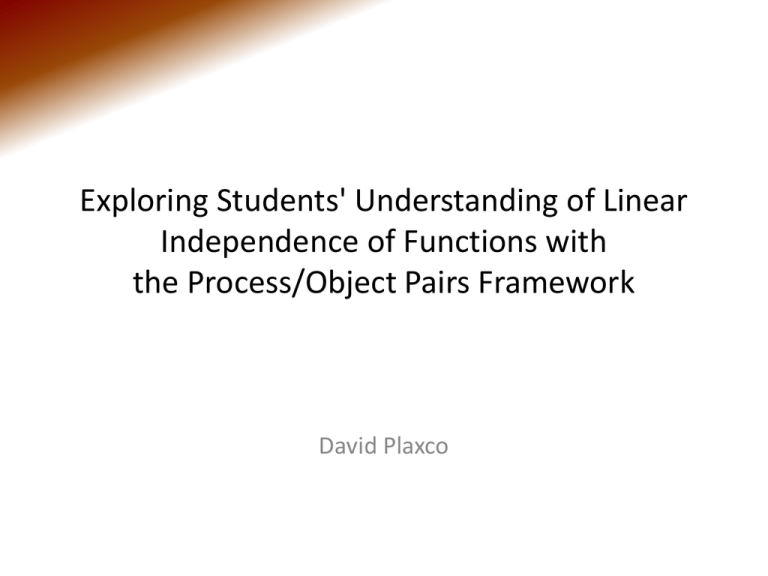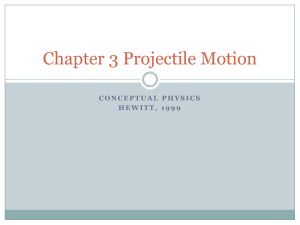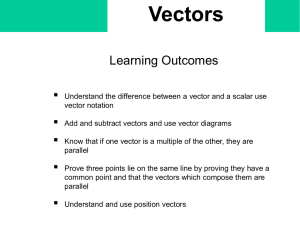slides
advertisement

Exploring Students' Understanding of Linear Independence of Functions with the Process/Object Pairs Framework David Plaxco Linear Independence of Functions • Definition of linear independence of vector-valued functions: Let fi: I = (a,b) → n, I = 1, 2,…, n. The functions f1, f2,…, fn are linearly independent on I if and only if ai = 0 (i = 1, 2,…, n) is the only solution to a1f1(t)+ a2f2(t) +…+ anfn(t) = 0 for all t I. Data Collection Description Fix t First Focus on Scalars Example Students evaluated the functions at one or more fixed value of t. Most then evaluated if the resulting real-valued vectors were LI or LD. Students carried out algebraic manipulations on the homogeneous vector equation (or related system of equations) without evaluating for specific t-values. They typically interpreted the results of their algebraic work by fixing the set of parameters and considering which/how many values of t satisfied the equation. “It is LI at some values of t for a given a set of values a, b, and c but not at others” “No, because for any a1, a2, a3, there exists a time t when the vectors are linearly independent, except for the zero vector.” “There are plenty of t's where aF + bG + cH ≠ 0 with the required values of a and b” “Can't change degree of t with scalar constants.” Function Combination Students seem to attend to linear combinations of t, t2, and t3 of a variable t that is not constant. These students did not evaluate the functions for specific t-values. Previous Rule Students relied on rules or generalizations about vectors in Euclidean spaces to determine linear (in)dependence of the set of functions. “No linear combination of t and t2 will ever yield t3, so they are LI.” “No because there is no way you can get one of the other vectors from a l.c. of the others. The only solution to a1F(t) + a2G(t) + a3H(t) = 0 is ai = 0, i = 1, 2, 3” “The set of equations would be L.D. because it has 3 components in R2.” “Yes, F(t), G(t), and H(t) are LD b/c there are three vectors in R2.” Description Fix t First Focus on Scalars Example Students evaluated the functions at one or more fixed value of t. Most then evaluated if the resulting real-valued vectors were LI or LD. Students carried out algebraic manipulations on the homogeneous vector equation (or related system of equations) without evaluating for specific t-values. They typically interpreted the results of their algebraic work by fixing the set of parameters and considering which/how many values of t satisfied the equation. “It is LI at some values of t for a given a set of values a, b, and c but not at others” “No, because for any a1, a2, a3, there exists a time t when the vectors are linearly independent, except for the zero vector.” “There are plenty of t's where aF + bG + cH ≠ 0 with the required values of a and b” “Can't change degree of t with scalar constants.” Function Combination Students seem to attend to linear combinations of t, t2, and t3 of a variable t that is not constant. These students did not evaluate the functions for specific t-values. Previous Rule Students relied on rules or generalizations about vectors in Euclidean spaces to determine linear (in)dependence of the set of functions. “No linear combination of t and t2 will ever yield t3, so they are LI.” “No because there is no way you can get one of the other vectors from a l.c. of the others. The only solution to a1F(t) + a2G(t) + a3H(t) = 0 is ai = 0, i = 1, 2, 3” “The set of equations would be L.D. because it has 3 components in R2.” “Yes, F(t), G(t), and H(t) are LD b/c there are three vectors in R2.” Description Fix t First Focus on Scalars Example Students evaluated the functions at one or more fixed value of t. Most then evaluated if the resulting real-valued vectors were LI or LD. Students carried out algebraic manipulations on the homogeneous vector equation (or related system of equations) without evaluating for specific t-values. They typically interpreted the results of their algebraic work by fixing the set of parameters and considering which/how many values of t satisfied the equation. “It is LI at some values of t for a given a set of values a, b, and c but not at others” “No, because for any a1, a2, a3, there exists a time t when the vectors are linearly independent, except for the zero vector.” “There are plenty of t's where aF + bG + cH ≠ 0 with the required values of a and b” “Can't change degree of t with scalar constants.” Function Combination Students seem to attend to linear combinations of t, t2, and t3 of a variable t that is not constant. These students did not evaluate the functions for specific t-values. Previous Rule Students relied on rules or generalizations about vectors in Euclidean spaces to determine linear (in)dependence of the set of functions. “No linear combination of t and t2 will ever yield t3, so they are LI.” “No because there is no way you can get one of the other vectors from a l.c. of the others. The only solution to a1F(t) + a2G(t) + a3H(t) = 0 is ai = 0, i = 1, 2, 3” “The set of equations would be L.D. because it has 3 components in R2.” “Yes, F(t), G(t), and H(t) are LD b/c there are three vectors in R2.” Description Fix t First Focus on Scalars Example Students evaluated the functions at one or more fixed value of t. Most then evaluated if the resulting real-valued vectors were LI or LD. Students carried out algebraic manipulations on the homogeneous vector equation (or related system of equations) without evaluating for specific t-values. They typically interpreted the results of their algebraic work by fixing the set of parameters and considering which/how many values of t satisfied the equation. “It is LI at some values of t for a given a set of values a, b, and c but not at others” “No, because for any a1, a2, a3, there exists a time t when the vectors are linearly independent, except for the zero vector.” “There are plenty of t's where aF + bG + cH ≠ 0 with the required values of a and b” “Can't change degree of t with scalar constants.” Function Combination Students seem to attend to linear combinations of t, t2, and t3 of a variable t that is not constant. These students did not evaluate the functions for specific t-values. Previous Rule Students relied on rules or generalizations about vectors in Euclidean spaces to determine linear (in)dependence of the set of functions. “No linear combination of t and t2 will ever yield t3, so they are LI.” “No because there is no way you can get one of the other vectors from a l.c. of the others. The only solution to a1F(t) + a2G(t) + a3H(t) = 0 is ai = 0, i = 1, 2, 3” “The set of equations would be L.D. because it has 3 components in R2.” “Yes, F(t), G(t), and H(t) are LD b/c there are three vectors in R2.” Description Fix t First Focus on Scalars Example Students evaluated the functions at one or more fixed value of t. Most then evaluated if the resulting real-valued vectors were LI or LD. Students carried out algebraic manipulations on the homogeneous vector equation (or related system of equations) without evaluating for specific t-values. They typically interpreted the results of their algebraic work by fixing the set of parameters and considering which/how many values of t satisfied the equation. “It is LI at some values of t for a given a set of values a, b, and c but not at others” “No, because for any a1, a2, a3, there exists a time t when the vectors are linearly independent, except for the zero vector.” “There are plenty of t's where aF + bG + cH ≠ 0 with the required values of a and b” “Can't change degree of t with scalar constants.” Function Combination Students seem to attend to linear combinations of t, t2, and t3 of a variable t that is not constant. These students did not evaluate the functions for specific t-values. Previous Rule Students relied on rules or generalizations about vectors in Euclidean spaces to determine linear (in)dependence of the set of functions. “No linear combination of t and t2 will ever yield t3, so they are LI.” “No because there is no way you can get one of the other vectors from a l.c. of the others. The only solution to a1F(t) + a2G(t) + a3H(t) = 0 is ai = 0, i = 1, 2, 3” “The set of equations would be L.D. because it has 3 components in R2.” “Yes, F(t), G(t), and H(t) are LD b/c there are three vectors in R2.” Description Fix t First Focus on Scalars Example Students evaluated the functions at one or more fixed value of t. Most then evaluated if the resulting real-valued vectors were LI or LD. Students carried out algebraic manipulations on the homogeneous vector equation (or related system of equations) without evaluating for specific t-values. They typically interpreted the results of their algebraic work by fixing the set of parameters and considering which/how many values of t satisfied the equation. “It is LI at some values of t for a given a set of values a, b, and c but not at others” “No, because for any a1, a2, a3, there exists a time t when the vectors are linearly independent, except for the zero vector.” “There are plenty of t's where aF + bG + cH ≠ 0 with the required values of a and b” “Can't change degree of t with scalar constants.” Function Combination Students seem to attend to linear combinations of t, t2, and t3 of a variable t that is not constant. These students did not evaluate the functions for specific t-values. Previous Rule Students relied on rules or generalizations about vectors in Euclidean spaces to determine linear (in)dependence of the set of functions. “No linear combination of t and t2 will ever yield t3, so they are LI.” “No because there is no way you can get one of the other vectors from a l.c. of the others. The only solution to a1F(t) + a2G(t) + a3H(t) = 0 is ai = 0, i = 1, 2, 3” “The set of equations would be L.D. because it has 3 components in R2.” “Yes, F(t), G(t), and H(t) are LD b/c there are three vectors in R2.” Process/Object Pairs • • • • • Sfard (1991) Dubinksy (1991) Gravemeijer (1999) Zandieh (2000) Norton (2013) Process/Object Pairs • • • • • Sfard (1991) Dubinksy (1991) Gravemeijer (1999) Zandieh (2000) Norton (2013) Process/Object Pairs • • • • • Sfard (1991) Dubinksy (1991) Gravemeijer (1999) Zandieh (2000) Norton (2013) Process/Object Pairs • • • • • Sfard (1991) Dubinksy (1991) Gravemeijer (1999) Zandieh (2000) Norton (2013) Process/Object Pairs • • • • • Sfard (1991) Dubinksy (1991) Gravemeijer (1999) Zandieh (2000) Norton (2013) Process/Object Pairs • • • • • Sfard (1991) Dubinksy (1991) Gravemeijer (1999) Zandieh (2000) Norton (2013) Thurston’s (2006) Various Descriptions of How One Might Think about Derivative Infinitesimal The ratio of the infinitesimal change in the value of a function to the infinitesimal change in a function. Symbolic The derivative of xn is nxn-1, the derivative of sin(x) is cos(x), the derivative of fog is f′og*g′, etc. Logical f′ (x) = d if and only if for every ε there is a δ such that when 0 < ⎥ Δx ⎥ < δ, Geometric The derivative is the slope of a line tangent to the graph of the function, if the graph has a tangent. Rate The instantaneous speed of f(t), when t is time. Approximation The derivative of a function is the best linear approximation to the function near a point. Microscopic The derivative of a function is the limit of what you get by looking at it under a microscope of higher and higher power. Zandieh’s (2000) Framework for the Concept of Derivative What’s the Point? Description Fix t First Example Students evaluated the functions at one or more fixed value of t. Most then evaluated if the resulting real-valued vectors were LI or LD. “Can't change degree of t with scalar constants.” Function Combination Students seem to attend to linear combinations of t, t2, and t3 of a variable t that is not constant. These students did not evaluate the functions for specific t-values. “No linear combination of t and t2 will ever yield t3, so they are LI.” “No because there is no way you can get one of the other vectors from a l.c. of the others. The only solution to a1F(t) + a2G(t) + a3H(t) = 0 is ai = 0, i = 1, 2, 3” Previous Context for LI • Definition of linear independence of vectors: n are linearly The vectors v1, v2,…, vn independent if and only if ai = 0 (i = 1, 2,…, n) is the only solution to a1v1+ a2v2+…+ an = 0. What’s the Point? Description Fix t First Example Students evaluated the functions at one or more fixed value of t. Most then evaluated if the resulting real-valued vectors were LI or LD. “Can't change degree of t with scalar constants.” Function Combination Students seem to attend to linear combinations of t, t2, and t3 of a variable t that is not constant. These students did not evaluate the functions for specific t-values. “No linear combination of t and t2 will ever yield t3, so they are LI.” “No because there is no way you can get one of the other vectors from a l.c. of the others. The only solution to a1F(t) + a2G(t) + a3H(t) = 0 is ai = 0, i = 1, 2, 3” Linear Independence of Functions • Definition of linear independence of vector-valued functions: Let fi: I = (a,b) → n, I = 1, 2,…, n. The functions f1, f2,…, fn are linearly independent on I if and only if ai = 0 (i = 1, 2,…, n) is the only solution to a1f1(t)+ a2f2(t) +…+ anfn(t) = 0 for all t I. Revisiting the Definition of LI of Functions • Definition of linear independence of vector-valued functions: Let fi: I = (a,b) → n, I = 1, 2,…, n. The functions f1, f2,…, fn are linearly independent on I if and only if ai = 0 (i = 1, 2,…, n) is the only solution to a1f1(t)+ a2f2(t) +…+ anfn(t) = 0(t). References Dubinsky, E. (1991). Reflective abstraction in advanced mathematical thinking. In Advanced mathematical thinking (pp. 95-126). Springer Netherlands. Gravemeijer, K. (1999). Emergent models may foster the constitution of formal mathematics. Mathematical Thinking and Learning, 1(2), 155-177. Norton, A. (2013). The wonderful gift of mathematics. Sfard, A. (1991). On the dual nature of mathematical conceptions: Reflections on processes and objects as different sides of the same coin. Educational Studies in Mathematics, 22, 1–36. Thurston, W. (1995). On proof and progress in mathematics. For the Learning of Mathematics, 15(1), 29–37. Zandieh, M. (2000). A theoretical framework for analyzing student understanding of the concept of derivative. Research in Collegiate Mathematics Education, IV (Vol. 8, pp. 103-127).








